How to Export WooCommerce Orders easily
While WooCommerce allows you to operate your online store fully from your WordPress dashboard, it’s still a good idea to set up your own order fulfillment and record-keeping systems. Understanding how to export WooCommerce orders is definitely one of the skills that can help you better manage and analyze your site’s purchases.
WooCommerce has a product exporter that works with CSV files. However, the platform only allows you to export orders in XML format. As a result, third-party programs will be required to export this data in CSV format.
To get a closer look at exporting orders, we will give you thorough instructions on how to export WooCommerce orders with ease in today’s article.
Let’s get started!
Why Do You Need to Export WooCommerce Orders?
WooCommerce has a built-in order management screen. Depending on the sort of items you offer, you may be able to keep track of all your clients’ purchases with only this function.
However, there are several scenarios that exporting orders can be helpful and you need to export orders, including:
- Saving the data to local storage
- Migrating an existing store to a new one
- Changing your hosting service
- Handling large orders
- Drop-shipping
- Analyzing order data
As you know, it’s usually a good idea to have a backup of your customer orders. Customers’ names, email addresses, order IDs, billing and delivery addresses, etc. are all included in orders. Therefore, instead of relying on your web server, you should save a copy of this data to your computer or via third-party cloud services such as Dropbox or Google Drive.
In general, you might need to export WooCommerce orders because of the flexibility it offers your online business management.
How to Export Orders in WooCommerce?
In this part, we will instruct you on how to export orders in WooCommerce using the plugin WooCommerce Customer / Order / Coupon Export by SkyVerge in a manual and automatic way.
1. Exporting orders manually
At any time, you can manually export customers, orders, and coupons. A modal will display when you start a bulk export or export items from the Orders or Users lists to let you know the export is processing:
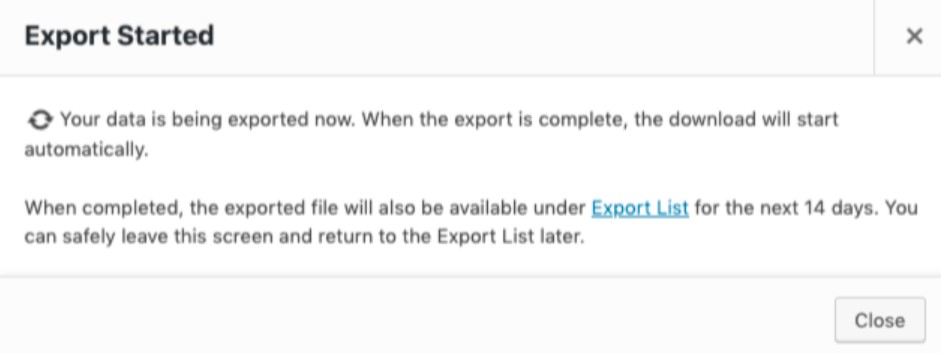
You can download the file from this modal if you leave it open while the export is running:

On the other hand, order exports are performed asynchronously in the background on your site, so you can exit the modal or leave your site entirely while the export is being completed.
If you exit the export modal, you can download the file from an admin notice that appears when the export is complete, or you can go to WooCommerce > Exports > Export List, where the exports are kept for 14 days.

Exporting data in bulk
Step 1: Navigate to Export section in WooCommerce
First, you need to log in to WooCommerce and go to the Export section in the admin panel.
Step 2: Update settings
In this step, you need to update the following settings on the Manual Export tab:
- Output type: Select whether your file should be exported in CSV or XML format.
- Export type: Select whether orders, customers, or coupons should be exported.
- Format: Choose from a variety of pre-defined or custom formats.
- Filename: Give the file created by this export a name.
- Export this file: Enable this option to ensure that the exported data is not included in future exports.
- Batch processing: Use this option only if your site doesn’t allow background processing.
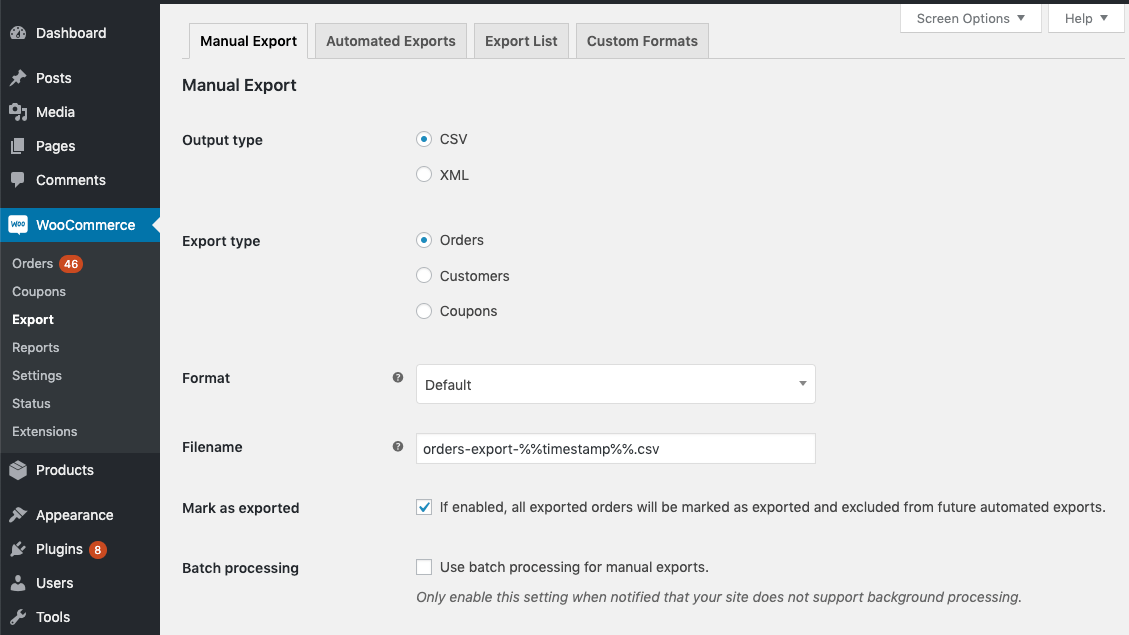
Step 3: Modify the Export Options section
Then you need to adjust the Export Options section to target certain orders (with order notes included), customers, or discounts. The available options will change depending on the Output type. that you’ve chosen.
Step 4: Click Export
After all the above modifications, you just need to click Export to finish.
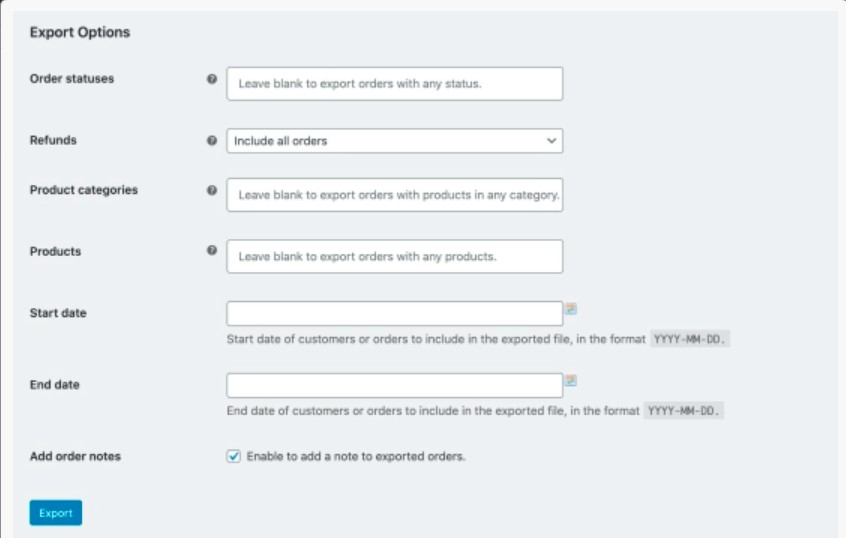
Exporting data from the Orders list
Step 1: Navigate to Orders section in WooCommerce
In this first step, you need to log in to your WooCommerce account and then go to the Orders section in the admin panel.
Step 2: Choose orders to export
To export, you need to choose one or more orders. The Exported filter can be used to display orders based on their export status.
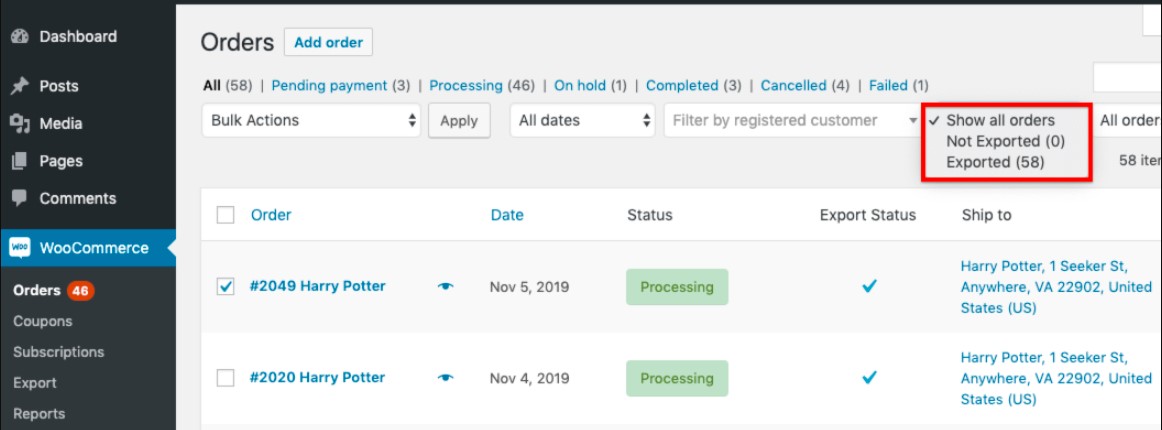
Step 3: Select actions
Here you have to choose the actions you prefer out of three options available in the Bulk Actions menu:
- Download to CSV
- Download to CSV
- Export and send: Export the the selected orders by FTP, HTTP POST, or email.
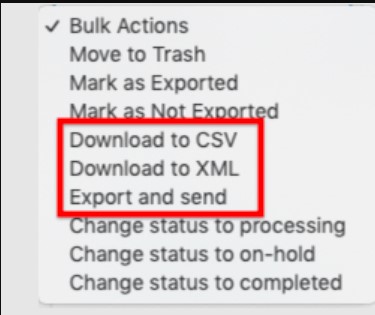
Step 4: Click Apply
Then, you just need to click on the button Apply .
-
If you choose an immediate download (for example, Download to CSV or Download to XML), you can retrieve the file as described above.
-
If you choose Export and Send, you’ll be prompted to choose one of your automatic order exports to send using the same transfer method. For this sort of export, only automated order exports via FTP, HTTP POST, or email transfer methods are available.
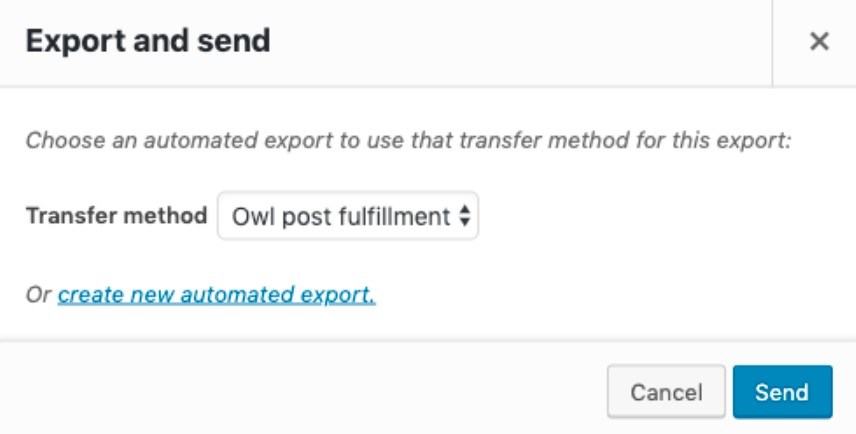
As soon as an order finished exporting from the Orders page, it will be automatically marked as exported.
2. Exporting orders automatically
You can establish one or more automatic exports to deliver customer or order export files on a regular basis if your site supports background processing.
Please read the following cautions regarding automatic exporting before getting started:
- Orders placed and customers created prior to the activation of this plugin will not be exported automatically. You may, however, label them as exported if you like.
- In automatic exports, only items designated as not exported will be included.
- The timezone of your WordPress site is used to schedule exports. Your timezone settings can be found under Settings > General.
Step 1: Go to Automated Exports
First off, you have to navigate to WooCommerce > Export > Automated Exports and then choose Add New.
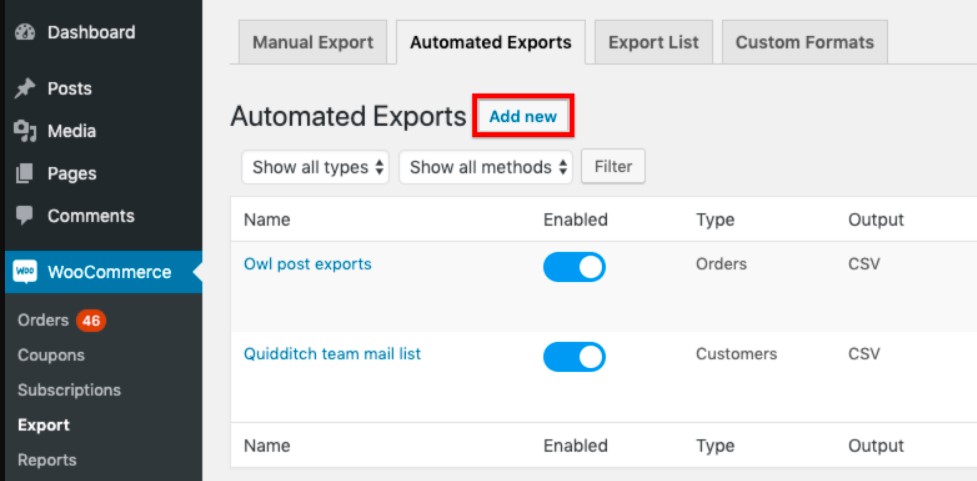
Step 2: Make some modifications
For the automatic export, you need to make the following changes:
- Enabled: Enable or disable automatic export.
- Export name: Give the export a unique internal name.
- Output type: Select whether your file should be exported in CSV or XML format.
- Export type: Select whether orders, customers, or coupons should be exported.
- Filename: Give the files created for the export a name.
- Format: Choose from a variety of pre-defined or custom formats.
Step 3: Adjust the Trigger automated export option
In this step, you need to define when the export will occur. To do that, you need to change the Trigger automated export option to your preferences.
- Order exports can be conducted as orders, paid orders, or at predetermined intervals.
- Customer exports can only be done at predetermined intervals.
Step 4: Change the Method setting
Here you need to decide how the export will be sent or tranferred by adjusting the Method setting.
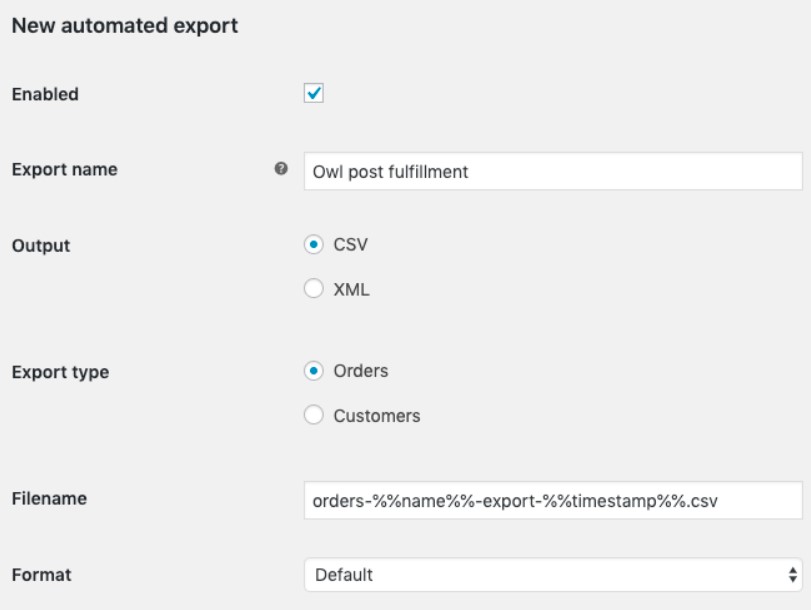
Recommended Plugins to Export Orders in WooCommerce
WooCommerce does not support exporting orders from its system, as we have already stated. To complete the export process, you will need to install a plugin. There are numerous plugins that help you to export WooCommerce orders. Below are 4 WooCommerce order export plugins that we recommended.
1. Advanced Orders Export
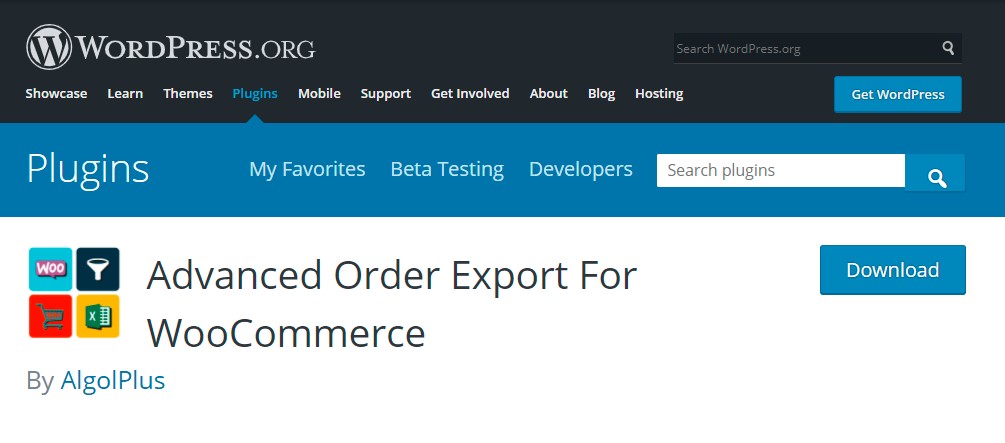
Advanced Orders Export allows you to export WooCommerce order data quickly and simply. Exporting any custom field given to orders/products/coupons gets easier with this plugin, and you can select from a variety of formats to export the data in, including CSV, XLS, XML, and JSON. Besides, not only can you export order data but you can also export summary order details, customer details, product attributes, coupon details,…
Features
- Export WooCommerce custom fields or terms for products/orders
- Rename labels
- Reorder columns
- Select all of your WooCommerce orders and conduct a mass “Export as…” procedure.
- Apply powerful filters
Price
Free to download and use. However, there is a Pro version of this plugin which costs you at least $25 per year.
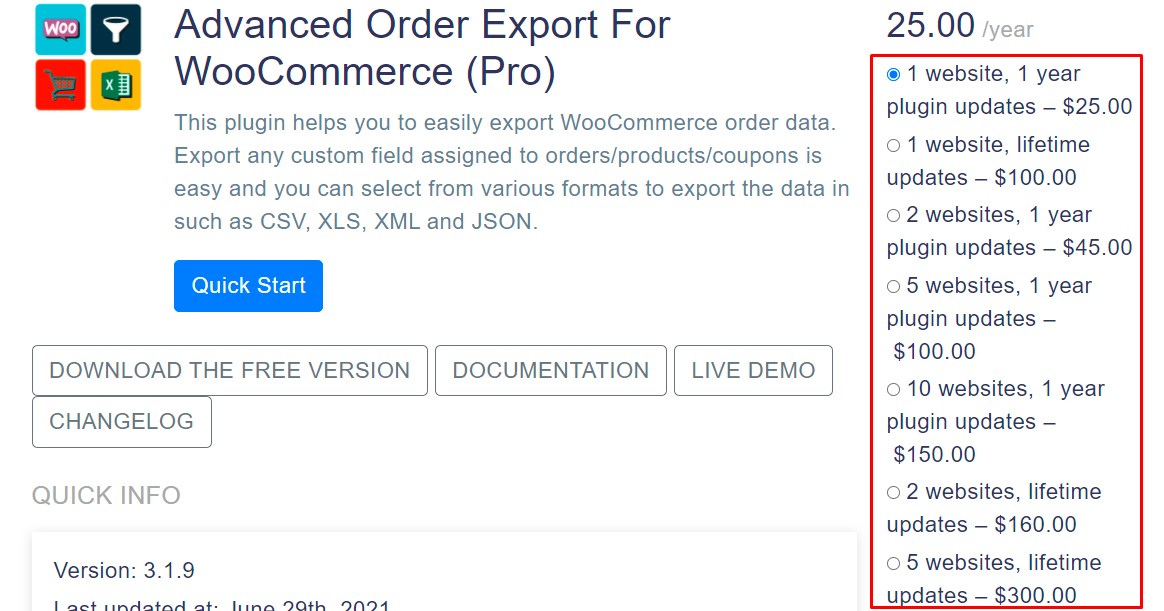
2. WP All Export

WP All Export lets you export a wide range of data, including customer information, order totals, shipping information, tax amount, order items, discount information, and more.
WP All Import plugin is especially known for its distinctive drag-and-drop interface, which facilitates file organization.
Features
- Reorder columns by dragging and dropping
- Exports on demand
- Powerful filters
- Scheduled exports
- WPML outputs in many languages
Price: $99.
3. WebToffee Order/ Coupon/ Subscription Export Import Plugin
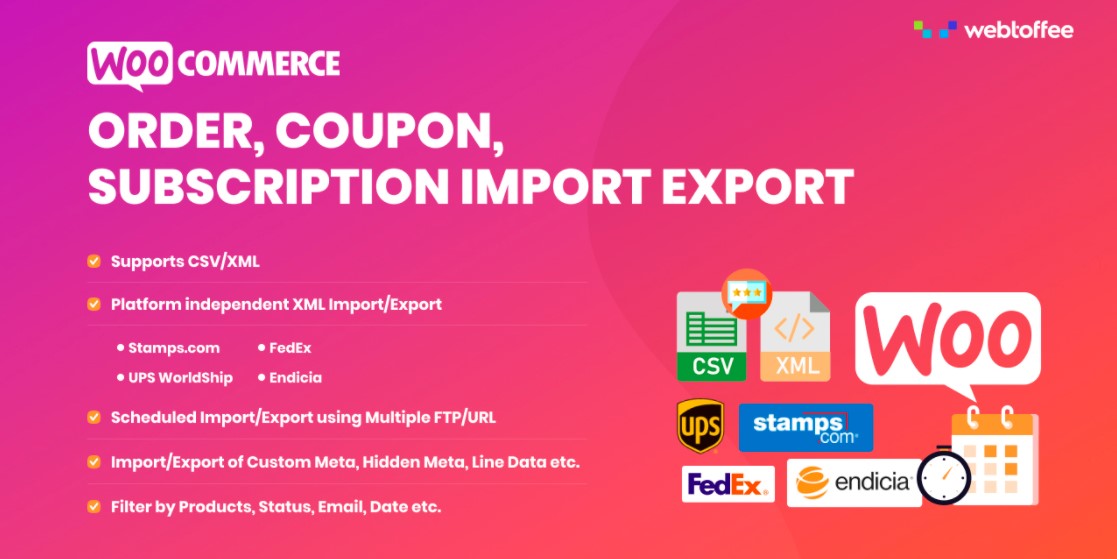
This plugin allows you to migrate not only order details but also subscriptions and coupons. It also supports data import, making it an ideal solution for moving data from or to your WooCommerce store. Besides, this plugin features a user-friendly interface that makes connecting WooCommerce data to CSV file column headings simple.
Features
- Export to or Import Orders/Coupons/Subscriptions from CSV/XML
- Allows import/export of orders from other formats
- Simple Ajax interface and flexible API
- Several filter options for custom import/export
- View detailed History, Debug logs, and Cron Schedules
Price
The plugin is $69.00 for a single-site license. A five-site license costs $99, while a twenty-five-site license costs $199.
4. WooCommerce Customer/ Order/ Coupon Export by SkyVerge
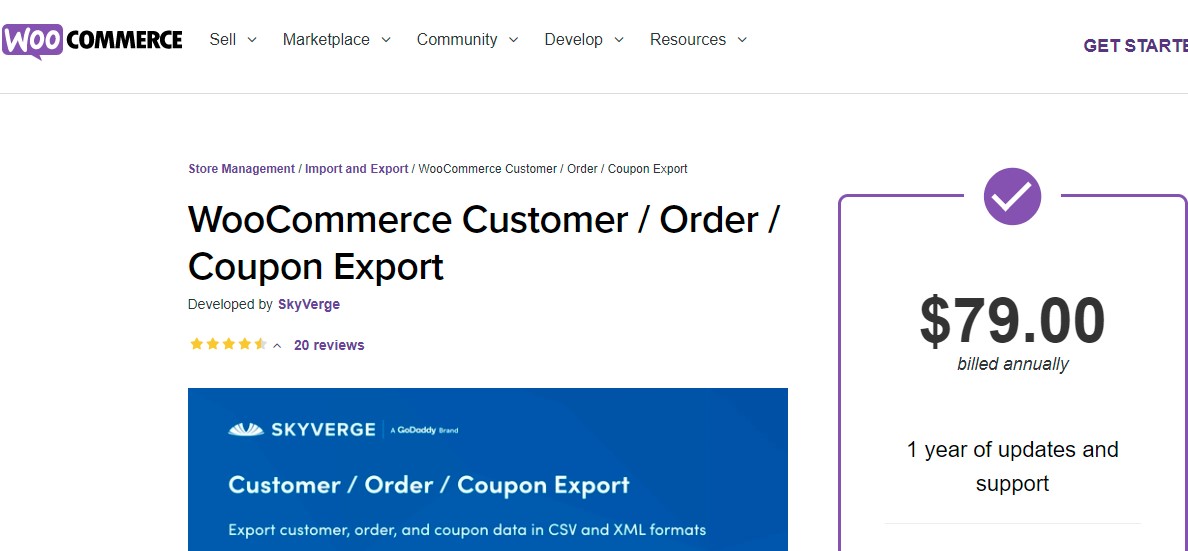
The WooCommerce Customer/ Order /Coupon Export plugin allows you to export individual orders, customers, or coupons, as well as build numerous automatic exports to send customer and order data through FTP, HTTP POST, or email. You can also make your own custom formats for any customers or order data.
More importantly, because the export process happens asynchronously in the background on your site, you can do other things or leave your site entirely while it is being processed.
Features
- Choose information to export from a customer record: name, email, address, etc.
- Customize the export fields to suit your requirements.
- Bulk export.
- Manually export orders and customers.
- Automatic export of orders and customers.
Price
This plugin is available for $79.00 for a single site subscription. You can purchase 5 site licenses for $109 and 25 site subscriptions for $179.
Final words
We hope that our instructions on WooCommerce export orders bring you a lot of useful information. If you have any questions, please feel free to comment down below. We would love to help you out.
Thank you for reading and we will be back in the next article.





